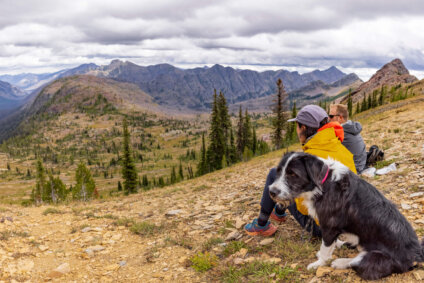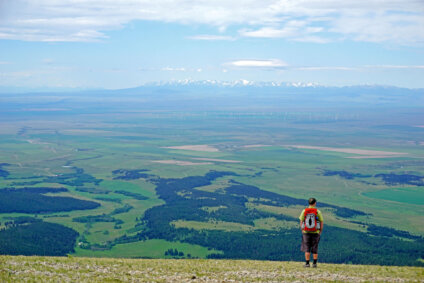Death by a Thousand Cuts
President Trump's proposed budget would have a devastating impact on our public lands and outdoor way of life
The day former Montana Congressman Ryan Zinke was confirmed as the new secretary of the Interior, he told his staff that he had seen President Trump’s proposed budget, which then contained a 10% cut to the department Zinke had just taken over. With the same bravado he displayed riding a horse to work on his first day at the department, Secretary Zinke announced he would fight that cut. “And I think I’m going to win at the end of the day,” he said, according to the Washington Post.
Not only did Sec. Zinke lose that fight, he lost ground. The cut his department faces in the proposed budget, released last week, is now at 12%, representing a decrease of $1.5 billion from the 2017 budget. The Department of the Interior oversees the Bureau of Land Management, the National Park Service, and the U.S. Fish and Wildlife Service, among other agencies. Rather than fight for these agencies’ budgets, Sec. Zinke quickly endorsed the president’s proposed cuts, saying it would still “allow the Interior Department to meet our core mission.”
So much for bravado and the horse it rode in on.
At 21%, the president’s proposed slash to Agriculture’s budget is even more draconian. The Department of Agriculture administers Montana’s largest land management agency, the U.S. Forest Service. According to the New York Times, the president wants to reduce funding to the Department of Agriculture by cutting the budget of the Forest Service, which already has to neglect many of its core duties because it now spends more than half its operating budget fighting fires. Because Congress has refused to fund firefighting in a smarter way, the Forest Service could very well end up consuming two-thirds of its budget in ten years, and certainly much more than that if Trump’s budget cuts are enacted.
Our land management agencies are already operating on threadbare budgets that prohibit them from completing many of their most basic functions and fulfilling their core missions. Any more cuts to the Forest Service and BLM, especially ones as drastic as the president proposes, would have a devastating impact on the public lands that make our way of life possible.
Here’s a sampling of the vital work our public land management agencies are already neglecting because of the budget constraints they currently face:
- Maintaining campgrounds, picnic areas, and trailheads that provide the public access to traditional hunting and fishing grounds. In a popular Bitterroot campground, for instance, a contaminated water system wasn’t replaced in 2015 because funding for it was diverted to fighting fires.
- Completing forest management and restoration projects that reduce fuel loads, improve water quality, and create much-needed jobs. In the Beaverhead-Deerlodge Forest, as an example, westslope cutthroat trout should have been restored to 25 miles of stream in 2015. That didn’t happen also because funding was diverted to firefighting.
- Treating thousands of acres of noxious weeds in Montana. Along the Rocky Mountain Front, for instance, the Forest Service said it needs to treat a minimum of approximately 879 to 1,149 acres every year to reduce infestation, but the agency can’t meet those goals because it doesn’t have the money to do so.
- Improving Forest Service roads to increase recreational access and protect fish and wildlife. In 2015, the Flathead National Forest was unable to complete re-surfacing on 20 miles of a primary access road in the Swan Valley because funding was diverted to firefighting.
- Conducting thorough landscape-scale planning. As an example, in 2015 the BLM’s Miles City Field Office completed its resource management plan but failed to conduct an on-the-ground wilderness inventory because it didn’t have staff capacity, even though the BLM’s own rules required the inventory.
- Proper law enforcement staffing. A total of nine law enforcement officers currently patrol the nearly 8 million acres of public lands the BLM manages in Montana, with one covering the entire eastern district. Two law enforcement officers currently patrol Montana’s largest national forest, the 3.35 million-acre Beaverhead-Deerlodge. This dearth of law enforcement is leaving protected areas vulnerable to illegal motorized use, archaeological sites vulnerable to looting and vandalism, and wildlife vulnerable to poaching.
Trump’s budget cuts would also have a terrible impact on the Land and Water Conservation Fund (LWCF), an immensely popular program that channels royalties from oil and gas development to cities and states, helping them conserve irreplaceable lands, improve outdoor recreation opportunities, and provide access to fishing, hunting, and hiking areas. This bipartisan program would lose $120 million under Trump’s budget, not only reducing access that hunters, anglers, and other recreationists enjoy, but also exposing our most scenic and special places to development.
______________________________________________________________________________
Our land management agencies are already operating on threadbare budgets that prohibit them from completing many of their most basic functions and fulfilling their core missions. Any more cuts to the Forest Service and BLM, especially ones as drastic as the president proposes, would have a devastating impact on the public lands that make our way of life possible.
_____________________________________________________________________________________
But the biggest hit to our public lands in Montana would probably land on trail maintenance. Ninety percent of all trails in Montana are under the purview of the Northern Region of the Forest Service, which manages nearly 29,000 miles of National Forest System trails from northeastern Washington to northwestern South Dakota. In 2015, the regional office was able to perform basic maintenance on only 13,000 of those miles. The remaining 16,000 miles went unmaintained for lack of funding.
When trails aren’t maintained, it’s not just Montana outdoorsmen and women who lose. So do Main Street businesses.
The town of Big Timber, Montana flies flags on its streets that say, “Recharge on our quiet mountain trails.” Those mountain trails are all on Forest Service lands, and so are the trails near Libby, Lincoln, and many other small towns across Montana. Those trails bring people from all over the country to our gateway towns, where they fill up on gas, eat in restaurants, and sometimes stay the night. Those trails contribute to Montana’s $6 billion outdoor recreation economy and the $403 million in tax revenue it generates. Without a properly functioning Forest Service or BLM, that economy is at risk, and so are the 64,000 jobs that currently rely on it.
Outdoor recreationists of all stripes have reason to be outraged by Trump's proposed budget. We urge Senator Jon Tester and Senator Steve Daines to fight this budget tooth and nail – to fight the way that Zinke pledged to fight before he folded. For far too long we’ve been expecting our public land managers to do more with less. Allowing those agencies to bleed to death, as the proposed budget would certainly do, would sap the energy from our economy, threaten our outdoor way of life, and degrade the lands and waters we hold so dear.
– John Todd, MWA conservation director

Stay Connected
"(Required)" indicates required fields


